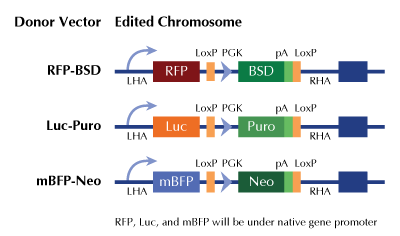VR1 (TRPV1) Human Gene Knockout Kit (CRISPR)
CAT#: KN217653LP
TRPV1 - human gene knockout kit via CRISPR, HDR mediated
Functional Cassette: GFP-puro RFP-BSD mBFP-Neo
HDR-mediated knockout kit validation
USD 1,657.00
4 Weeks*
USD 450.00
USD 768.00
Specifications
| Product Data | |
| Format | 2 gRNA vectors, 1 Luciferase-Puro donor, 1 scramble control |
| Donor DNA | Luciferase-Puro |
| Symbol | VR1 |
| Locus ID | 7442 |
| Components |
KN217653G1, VR1 gRNA vector 1 in pCas-Guide CRISPR vector KN217653G2, VR1 gRNA vector 2 in pCas-Guide CRISPR vector KN217653LPD, donor DNA containing left and right homologous arms and Luciferase-Puro functional cassette. GE100003, scramble sequence in pCas-Guide vector |
| Disclaimer | These products are manufactured and supplied by OriGene under license from ERS. The kit is designed based on the best knowledge of CRISPR technology. The system has been functionally validated for knocking-in the cassette downstream the native promoter. The efficiency of the knock-out varies due to the nature of the biology and the complexity of the experimental process. |
| Reference Data | |
| RefSeq | NM_018727, NM_080704, NM_080705, NM_080706 |
| UniProt ID | Q8NER1 |
| Synonyms | VR1 |
| Summary | Capsaicin, the main pungent ingredient in hot chili peppers, elicits a sensation of burning pain by selectively activating sensory neurons that convey information about noxious stimuli to the central nervous system. The protein encoded by this gene is a receptor for capsaicin and is a non-selective cation channel that is structurally related to members of the TRP family of ion channels. This receptor is also activated by increases in temperature in the noxious range, suggesting that it functions as a transducer of painful thermal stimuli in vivo. Four transcript variants encoding the same protein, but with different 5' UTR sequence, have been described for this gene. [provided by RefSeq, Jul 2008] |
Documents
| Product Manuals |
| FAQs |
| SDS |
Resources
Other Versions
| SKU | Description | Size | Price |
|---|---|---|---|
| KN217653 | TRPV1 - human gene knockout kit via CRISPR, HDR mediated |
USD 1,657.00 |
|
| KN217653BN | TRPV1 - human gene knockout kit via CRISPR, HDR mediated |
USD 1,657.00 |
|
| KN217653RB | TRPV1 - human gene knockout kit via CRISPR, HDR mediated |
USD 1,657.00 |
|
| KN417653 | TRPV1 - KN2.0, Human gene knockout kit via CRISPR, non-homology mediated. |
USD 1,657.00 |
|
| GA105129 | TRPV1 CRISPRa kit - CRISPR gene activation of human transient receptor potential cation channel subfamily V member 1 |
USD 1,657.00 |
{0} Product Review(s)
Be the first one to submit a review






























































































































































































































































 Germany
Germany
 Japan
Japan
 United Kingdom
United Kingdom
 China
China
